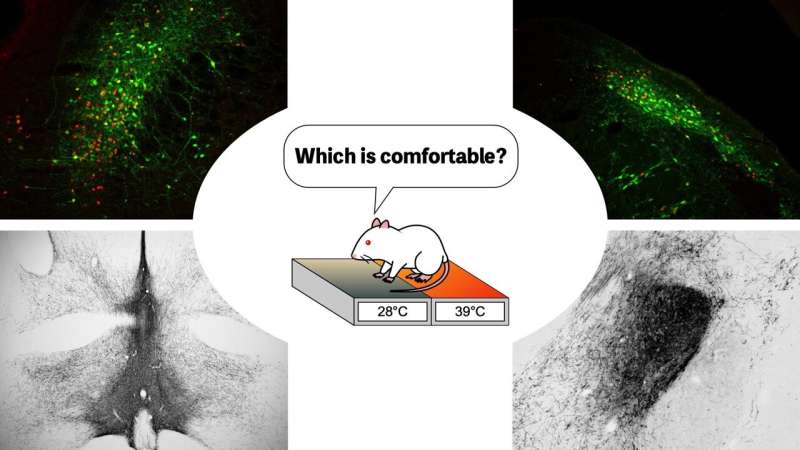This article has been reviewed according to Science X's editorial process and policies. Editors have highlighted the following attributes while ensuring the content's credibility:
fact-checked
peer-reviewed publication
trusted source
proofread
Understanding brain network that connects temperature sensation and emotion may help prevent heatstroke

A research group from the Nagoya University Graduate School of Medicine in Japan has identified the neural pathways in the brain that influence thermoregulatory behaviors in rats.
Thermoregulatory behaviors are the behavioral processes by which all animals regulate body temperature in response to changes in the environment. These findings, published in the Journal of Neuroscience, provide a better understanding of the neural network of the brain, and also suggest new medical strategies for the prevention of heatstroke.
All animals, including humans, use thermoregulatory behaviors to maintain body temperature within certain limits, even when the surrounding temperature is very different. Strategies include finding warmer or cooler spaces and adjusting body posture. More specific examples include a turtle basking in the sun or a person who uses air conditioning and wears a t-shirt and short pants in the summer.
In a previous study, a research group at Nagoya University reported that thermoregulatory behavior requires a region of the brain called the lateral parabrachial nucleus (LPB). The group included Nagoya University graduate student Takaki Yahiro, Lecturer Naoya Kataoka, and Professor Kazuhiro Nakamura. In a new study, the same team identified two different groups of neurons in the LPB that transmit thermosensory information from skin thermoreceptors to different areas of the forebrain.
The two groups of neurons were found to form distinct thermosensory pathways. The first group transmits a warm and cold sensation to a region called the median preoptic nucleus (MnPO). Meanwhile, the other group transmits only a cold sensation to the central nucleus of the amygdala (CeA).
The amygdala is found deep within the temporal lobe of the brain and is essential for different aspects of emotional processing and behavior, including anxiety, fear, and threat response. But researchers did not know that it was also involved in thermoregulatory behavior.
The researchers suspect that the neural pathways they identified form unpleasant emotions to drive thermoregulatory behaviors. Their findings may contribute to a better understanding of the causes of heatstroke and hypothermia. For some people, the neural pathways may not form unpleasant emotions in response to sensations of heat and cold. As a result, they may not act even when the surrounding temperatures change.
To test this possibility, the researchers blocked one of the thermosensory pathways from the LPB in rats. When the pathway to MnPO was blocked, rats did not avoid heat, leading some to experience increases in body temperature above the normal range. In contrast, blocking the pathway to the CeA abolished the rat's behavior to avoid cold.
A similar process may occur in humans, especially among older adults. According to Nakamura, "As people age, the generation of heat and cold discomfort through the LPB may be weakened due to the reduced temperature sensitivity of the skin's thermosensors. This may cause them to fail to perform their thermoregulatory behavior."
Therefore, older people should avoid basing their thermoregulatory behavior on subjective factors such as emotions. Instead, they should respond to objective changes in air temperature and humidity. For example, a person should move somewhere cooler based on thermometer and hygrometer readings in the summer, even when not experiencing discomfort.
More information: Takaki Yahiro et al, Two Ascending Thermosensory Pathways from the Lateral Parabrachial Nucleus That Mediate Behavioral and Autonomous Thermoregulation, The Journal of Neuroscience (2023). DOI: 10.1523/JNEUROSCI.0643-23.2023




















